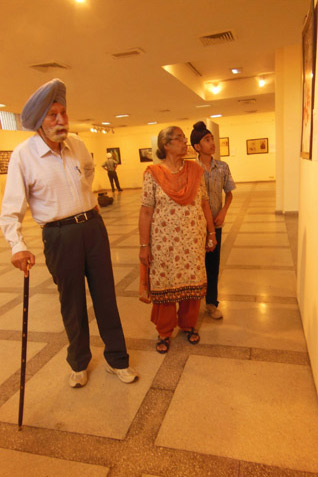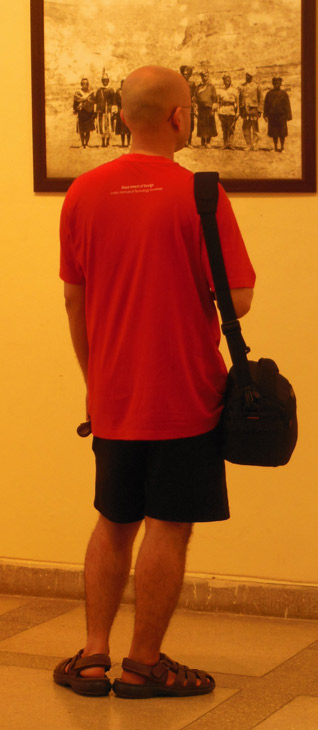Current Events
The Small Voices of History:
The Work of The Panjab Digital Library, et al
SARITA RAMAMOORTHY
"Archivists do the thankless job of keeping the important resources available to researchers. Now it is time to acknowledge their role in knowledge production”, said Gurdarshan Singh Dhillon, chief guest at the inauguration of Lived Stories Everyday Lives.
Showcasing images from different private collections in South Asia, the exhibition Lived Stories Everyday Lives, brought together images captured by common people, others by amateurs, and some by professionals.
Jointly organised by the Panjab Digital Library
(PDL - in Chandigarh, Punjab) and the Hri Institute for Southasian Research and Exchange (Kathmandu, Nepal), the exhibition opened to an enthusiastic response at
the Punjab Kala Bhawan in Chandigarh.
Prof Gurdarshan Singh lauded the efforts of the Panjab Digital Library in the digitization of manuscripts and rare books, and of Hri at co-ordinating of archives in South Asia. Remarking on the showcasing of the common thread of lives of ordinary people across Punjab and other parts of South Asia, he underlined the importance of sharing experiences as preserved in personal archives.
He pointed out that history should also be understood
beyond iconic events and personalities as common people need to be
acknowledged for shaping our culture and lives. He added that archivists
seldom come to the forefront as compared with historians, who enjoy the
limelight.
Countries on the subcontinent not only share borders but also histories.
Moving beyond borders, unique different images came together in this
single exhibition.
Over 25 images from different private collections were showcased, the highlight being a special section on Punjab, which was curated by the Panjab Digital Library.
Through a series of pictorial and textual vignettes -- be they graduation photos or studio portraits, post cards or holiday photos -- this exhibition attempted to present an understanding of how the past is all around us. The events and the activities that have shaped our collective consciousness -- the so-called big moments of history -- are understood here in terms that are accessible to people in a language and framework of their own.
This is a tiny effort to look at how everyday lives have been lived, and how they have been chronicled. It is the “small voices of history” that are sought to be brought to the fore here: people who have elided the ‘great’ narratives of history offered through history books, national dailies and the media. Here, postcards, advertisements, calendars, letters, family albums and studio photographs told the stories of everyday lives as well as extraordinary events in the lives of ordinary people.
Putting together the exhibition in a large hall was a first for both organisers and a daunting experience. The Punjabi summer not only made us sweat a fair share, but had us worried about whether people would venture out of their comfortable homes. The sight of visitors pouring in after the inauguration was reassuring.
The images from the 1947 Partition of Punjab a chord with many Punjabis who recalled experiences of their own and their families. Two black & white images; one of a group of nuns in Tibet and the second of soldiers, from the famous Younghusband mission of 1903, were visually striking and also amongst some of the oldest in the exhibition.
The images were from Punjab and from different parts of India, Pakistan, Sri Lanka, Nepal, Afghanistan, Tibet, and Bangla Desh, but despite different nationalities, the visitors felt one with the stories and every image invoked a new story in each visitor. People took time to carefully read every single story accompanying the image, and often stopped to discuss their own heart-warming stories. The comments from the visitors, all from different walks of life - were positive and encouraging.
Some comments:
A glimpse of past in present is admirable. Best wishes for the future.
- Gurleen Kaur
A delightful curation and it seems like just a sampling of the immense variety of personal and public memories we carry.
- Janaki Srinivasan, Punjab University
A brilliant initiative, well-rounded. Wish it had more pictures and installations. All the very best.
- Amandeep Singh Sandhu, Author.
The exhibition is very unique in terms of the theme and collection.
Photographs collected from different sources and exhibited are really
beautiful and take the visitor to a B/W era. It arouses nostalgic
feelings in me. I’ll cherish it. Commendable effort.
- Prof. Atul Sharma
[Courtesy: Hri Institute for Southasian Research & Exchange. Edited for sikhchic.com]
August 10, 2013
Conversation about this article
1: Bhai Harbans Lal (Dallas, Texas, USA), August 10, 2013, 9:58 PM.
These projects are engaged in providing a unique service and need support from every quarter. Your daswand will be well spent here.
2: Harinder (Punjab), August 15, 2013, 10:42 AM.
Our historians need to keep a meticulous record of Sikhs country-wise across the diaspora, with immediate effect. Our history is begging to be recorded and written.




